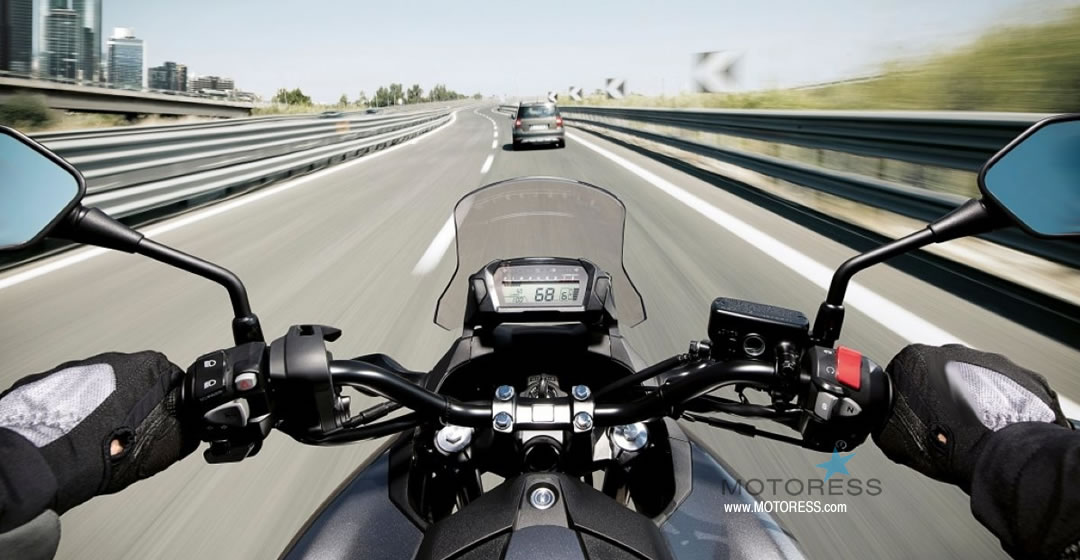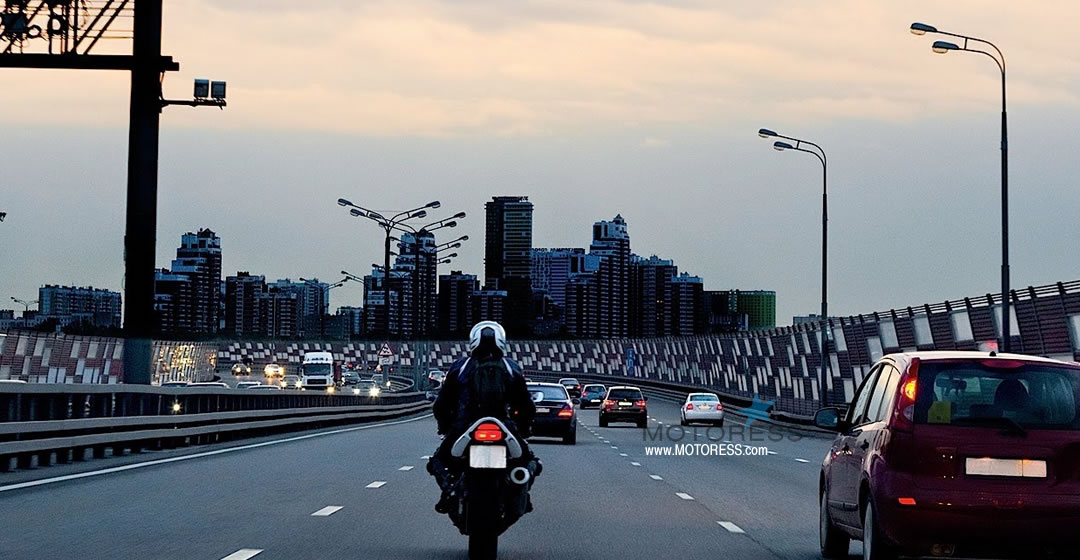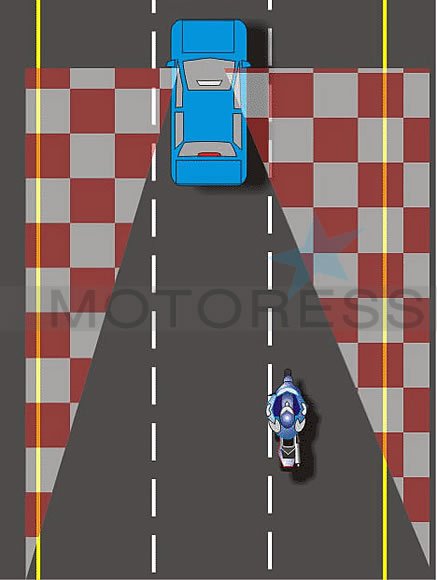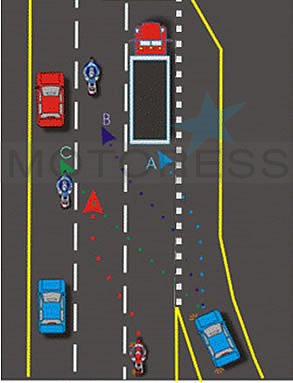Last Update: 19 March 2023

Many claim riding your motorcycle on an express highway can be more secure than that on secondary roads of lower speeds. With the absence of intersections and general – greater visibility – expressways can allow for uninterrupted constant speeds. The pace is faster and the traffic generally moves at about the same speed in the same direction. However, managing risks when riding on expressways and highways is something every rider needs to remain diligent about. Expressways are still without risks for motorcycle riders.
Riding On Expressways: Situational Awareness
Travelling on an expressway means a lot is done in a short time. Automobiles join in, change lanes; brakes suddenly go on and off – vehicles move in and out. We must, especially as motorcyclists be very aware of our environment. This is called situational awareness.
Because we are not able to see all at a quick glance, we need to form a mental picture of what’s happening around us. By using our mirrors to look around us, we can merge partial observations giving us a picture of what actually is happening to us. We can also estimate where a car is behind us.
For example, if you think the vehicle behind is increasing speed and intends to overtake you, you will not think of making a lane change.
Environmental Consciousness
Soon, however, this picture becomes incomplete. As we are not constantly getting new information, we end up creating an incorrect mental picture and potentially bring ourselves into the danger zone. This is especially true on the highway since with higher speeds, situations change much quicker.
Therefore a good lane position means a place where you can see as much as possible; resulting in your eventual safety. For example by riding in the right of the lanes centre (shoulder side lane) you’ll be able to see further ahead and be able to get access to traffic situations approaching meaning you’ll be prepared. All of this depends on the situations around you and your need to be ready and visible
Riding Behind Trucks / Large Vehicles
Riding after large trucks, buses or vans will greatly reduce your vision advantage putting you at risk. They block your view more than other vehicles and create a strong air disturbance behind them. Try as much as possible to create space and avoid riding behind such vehicles for any length of time. If you can’t control the fact of riding behind these large vehicles, then create extra following distance far behind them until you can see beyond the truck or bus.

Following Distance: The 2-3 Second Rule = Time to React
On the expressway always keep at least a two to three-second distance behind the vehicle in front of you. Keep a cushion of space all around you and avoid driving in the blind spots of other vehicles. Stay clear of large vehicles. They block your view more than other vehicles and create a strong air disturbance behind them. If you get behind one of these vehicles, the wall of wind can whip around your motorcycle, making it difficult to control. It’s very important you keep the right amount of following distance to have the time and space to react. if a vehicle comes between you and your count, simply readjust and establish the three-second count again.
Take into account the line of sight you need ahead, and take measures that enhance your sight. You’ll be able to properly respond and manoeuvre to unexpected events. These unexpected events may have been a drivers brake lights suddenly illuminating, vehicle lane changes, etc.
When you shorten your following distance to the vehicle in front of you, you multiply the time needed to react. Here you need to ask yourself, are your emergency and push steering recovery techniques honed and perfect?
Speed, traffic density, atmospheric conditions and the condition of the roadway are all factors to be taken into consideration in determining a “prudent and reasonable” following distance.
Always bear in mind that an automobile can brake quickly without notice. The further you are behind a (chain) collision, the lesser the impact and the slower you’ll arrive on your forerunner. And we haven’t even considered the vehicles driving behind you. Think twice about the amount of sufficient distance you need. Make sure you always have enough room to react and manoeuvre in front of you and beside you.
And never be the last vehicle to stand still in a traffic jam or the last moving with your motorcycle!
Be Seen
No matter the situation, be sure you’re out there and visible. Far too often autos and motorcycles are crushed between two trucks, because the rear truck driver is not paying attention. This is achieved by lane positions, left, centre or right tire track. Wearing bright clothing as well as brightly coloured helmet will also help.
Lane Changes
When making lane changes, left or right, do so one lane at a time – never move two or more lanes at the same time. Ride in the spotlight. In doing so, look out for vehicles which may end up moving at the same time as you go into the same lane!
Never combine looking and steering at the same time. There are three separate steps to be done before making the actual lane change move:
-
- Do a traffic check/check the space/ look (mirrors, consider the blind spot);
- Signal (at least twice)
- One last traffic check (over the shoulder)
. . . then move/steer.
Your Following Distance
It happens often, but make sure the vehicle behind you is at a safe distance too and not following you too closely. Here firstly you’ll want to give yourself even more room in front or change lanes. You can chose to accelerate, if safe to do so, creating more distance between you and the vehicle following you or simply pull over – into a side street, etc. and let the vehicle pass.
Also if you are in a situation where this might apply, you can also try carefully changing your tire- track position to place you in the part of the lane where you’ll be in the front of the driver’s steering wheel. The driver will likely not notice you’ve moved yet this will slightly obstruct the drivers view giving them the feeling you are closer.

Hazards
Dangers to a motorcyclist on the expressway come generally from oncoming traffic – traffic from side roads – and traffic joining or exiting. On the right side of the motorway you have to deal with merging and deceleration areas. It makes sense to stay as far away from these danger zones as. And never go between a vehicle and a deceleration lane.
Herd
Motorists behave just like animals in a herd and tend to pack together – densely. Try not to become a member of the pack and put these groups behind you.
Have An Out
If traffic begins to slow in front of you, move slightly to the left or right of the car in front of you, so you have an
escape route should something go wrong. Keep an eye on your mirrors to be prepared if something goes wrong behind you – such as the following vehicle appearing not to stop. And if stopped – clutch in, bike in gear, eyes in the mirrors, blind spot checks to both sides. When the hazard ahead of you is under control, there are still those to deal with behind you.
Take advantage of the flexibility of your motorcycle by making use of open spaces in the traffic. There is always a hole, always know where it is.
Scan constantly, and watch out for hazards, check your mirrors, look over your shoulders. Make sure you always have an escape route in mind should something go wrong.
Watch out for riding in the blind spot of the driver’s vehicle. In the diagram #2. the blind spot is indicated by the red/white blocks.
These areas are bigger than you think. And remember, that vehicles on the roadway with slow-moving traffic will want to move to the lane where traffic moving faster.
Breakdown on the Expressway
Bad luck on the expressway can happen. First step is to get yourself safely off the expressway and to an area where you’ll be out of danger. If there’s a guard rail next to the shoulder, park your motorcycle parallel with the guard rail and as close as to it as possible. If you discover your problem is not easily fixed, protect yourself and stand behind the guard rail.
And the universal sign for a motorcyclist in trouble is a helmet on the ground – intentionally placed by the bike.
Miscellaneous
Faster speeds for long distances can be stressful. The constant wind pressing against your neck and head, clothing flap around, wind sounds and cramping because you are constantly huddled. In addition, there’s increased dehydration which is not to be underestimated. Either short or long rides on the expressway you will need to take more breaks to hydrate, relax and stretch your body.
Riding on the expressway, as in its name “express” sums it up. You’ll travel more efficiently to your destination and generally more steadily and quicker. But sometimes it’s not the best choice and taking an alternative road just ends up being the better option.
Plus with today’s GPS systems taking a random alternative road is a whole lot easier!
Ride smart – it’s all up to you!






1 comment
thankyou